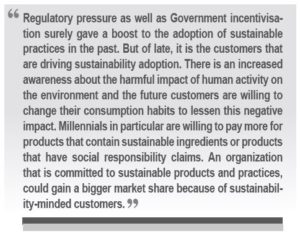Sustainability has become a powerful worldwide movement with government, industry and civil society realising that there is no other way, other than putting sustainability principles to work and into action to ensure that future generations are left with enough resources for their comfortable living on earth, that the ill effects of climate change are reversed before it reaches a point of no return and our entire living shifts to using materials that are totally benign to the environment, recyclable with no waste.
Sustainability is moving into wider and wider deployment in industry. What is the plan of action for its effective implementation and how can the results from transition to sustainable operations from each industry and every company be measured.
Chemical Industry Digest in this special focus on sustainability in the chemical industry, discusses, debates and articulates the views of CEOs of global MNCs and major chemical companies, premier research organisation and global renewable carbon research and consultancy organisation.
Chemical Industry Digest is privileged to obtain the views of Ravi S Jalan, Managing Director, GHCL. His views are presented here.
 Ravi S Jalan, Managing Director, GHCL, is a first Class, Commerce Graduate (Hons) and a Fellow Member of the Institute of Chartered Accountants of India, New Delhi (FCA). With more than 25 years of experience in senior leadership positions in different Units of Dalmia Group of Companies. His in-depth understanding of business structuring, planning and operations, a keen focus towards developing R&D, marketing and exports, diversification and modernization have made GHCL an organisation of repute. He has been instrumental in the phenomenal growth of GHCL’s soda ash and home textiles segments. He was ranked 29th in the list of Top 100 CEOs based on BT – PWC Best CEO survey in 2017.
Ravi S Jalan, Managing Director, GHCL, is a first Class, Commerce Graduate (Hons) and a Fellow Member of the Institute of Chartered Accountants of India, New Delhi (FCA). With more than 25 years of experience in senior leadership positions in different Units of Dalmia Group of Companies. His in-depth understanding of business structuring, planning and operations, a keen focus towards developing R&D, marketing and exports, diversification and modernization have made GHCL an organisation of repute. He has been instrumental in the phenomenal growth of GHCL’s soda ash and home textiles segments. He was ranked 29th in the list of Top 100 CEOs based on BT – PWC Best CEO survey in 2017.
Chemical Industry Digest (CID): Sustainability has become a loosely bandied word with many companies using the word sustainability as a promotional word attached to their company brand identity. How can we rid the concept of an arbitrariness and introduce a practical set of matrices to define it clearly? What are its more important components & characteristics, based on which best in class, measurable outcomes can be drawn?
Ravi S. Jalan (RSJ): Sustainability, as the word implies, refers to processes and products which can be practised and maintained with the lowest impact possible on climate change, biodiversity and the ecological balance. But if you say, that sustainability has become a loosely bandied word being used to enhance brand image, then I would disagree. Sustainability is a mind set and enables organisations to secure and shape up for the future. Many organisations have started realizing that a lot of savings can be achieved by implementing sustainability programs across the value chain. Also, many customers are sceptical of companies that only declare their intentions for sustainable development but do very less when it comes to measuring actual outcomes.
 In my opinion, to ensure sustainability, organisations must invest in adopting business models which are more resilient, keep pace with rapid technological developments and factor their impact on the environment and society. In order to address the arbitrariness, we must realize that there are no one size fits all approach to sustainability. But, one thing that applies to most organisations is to ensure progress in a responsible way, consistency, action and a long term vision. Targets must be realistic and progress measurable and sustainable practices should be reflected in every aspect of the business.
In my opinion, to ensure sustainability, organisations must invest in adopting business models which are more resilient, keep pace with rapid technological developments and factor their impact on the environment and society. In order to address the arbitrariness, we must realize that there are no one size fits all approach to sustainability. But, one thing that applies to most organisations is to ensure progress in a responsible way, consistency, action and a long term vision. Targets must be realistic and progress measurable and sustainable practices should be reflected in every aspect of the business.
To measure and reduce carbon footprint we must ensure:
• Measuring and managing energy consumption
• Recycling products and waste
• Measuring savings as a result of various conservation and improvement efforts
• Supplier sustainability compliance
• Improving supply chain sustainability
• Reducing water footprint
• Reducing waste and recycling rejects
CID: To put sustainability principles into practice, how should an industry/manufacturing unit go about it? What could be a practical roadmap with a plan of action?
RSJ: Manufacturing processes designed for sustainability keep in mind the environmental and social aspects. When implementing Sustainable Manufacturing, the best way is to an examine fully the environmental impact of different activities performed including the production of goods. This means that every stage of activity needs to be evaluated, from raw material extraction, through production, distribution, consumption, and ultimately, disposal. Manufacturing processes and systems need to consider sustainability at every level, so that there is a comprehensive adherence to sustainability principles.This approach, which emerges from a sustainability mind set, encourages us to study the whole process
rather than a single operation of the company. This can help us to significantly expand the horizon, find new solutions and identify issues that have not been noticed earlier. Additionally, taking a closer look at operational costs can shed light on the low-hanging fruit and present significant savings opportunities in low-cost initiatives like employee awareness campaigns, light motion sensors, energy efficient equipment, low-consumption light bulbs and greater use of natural light. These simple initiatives can also have a profound impact on reducing energy costs.
CID: Business and industry are until now modelled on profitability outcomes which override other concerns. So how can corporates transit to the platform of sustainability, from the current mind-set of take – make – and dispose? What would be the net benefits to
companies for shifting to sustainability? Would it entail additional costs for its products and services?
RSJ: There is often a misconception that environmental practices require high capital expenditure. In practice, “going green” actually lowers costs, the result is a virtuous cycle with benefits for the bottom line, the corporate image and the environment. Companies need to chalk out a strategic approach. For example, the primary focus in the manufacturing industry is on production, as this generates the highest energy costs. On an average, majority of cost-cutting and emission reducing opportunities involve behavioural, procedural and maintenance changes rather than investment in new equipment. Most potential savings can be identified by the in-house technical staff through the use of crossfunctional workshops, discussions and structured root-cause analysis. The incorporation of sustainability practices into corporate strategy and the operational framework can bring down costs, reduce carbon emissions and also boost the company’s brand and image. Sustainability needs to be an embedded process with clear objectives, roles and management tools. A compan y deciding to implement environmental initiatives must have an effective tracking system for achievable and measurable results. It is important to balance the top-down approach with a bottom- up commitment to create more awareness, acceptance and a culture of change within the organization.
y deciding to implement environmental initiatives must have an effective tracking system for achievable and measurable results. It is important to balance the top-down approach with a bottom- up commitment to create more awareness, acceptance and a culture of change within the organization.
CID: What factors are driving the adoption of sustainability by companies? Is it due to governmental pressures from global climate control treaties and societal pressures or is it intrinsically driven? What enabling factors can drive sustainability at an accelerated pace? Regulatory pressures? Governments incentivising the transition? Easier access to cost-competitive cleaner technologies? Access to cheaper funding for R&D and innovation? What else?
RSJ: Organisations are now able to understand the positive impact of adopting sustainable practices. In addition to driving social and environmental change, sustainability initiatives are contributing to an organization’s overall success. It may seem counterintuitive that spending more money on sustainable business practices can boost a company’s profitability, but studies show that the most sustainable companies are also the most profitable. Cost efficiencies, reputation and image enhancement, better employee morale and retention are the major reasons driving adoption of sustainability. There are lots of ways in which being more sustainable is helping businesses – more efficiency, better reputation, more innovation, attract and retain employees, growth, reduction in costs and strengthening stakeholder relations.
Regulatory pressure as well as Government incentivisation surely gave a boost to the adoption of sustainable practices in the past. But of late, it is the customers that are driving sustainability adoption. There is an increased awareness about the harmful impact of human activity on the environment and the future customers are willing to change their consumption habits to lessen this negative impact. Millennials in particular are willing to pay more for products that contain sustainable ingredients or products that have social responsibility claims. An organization that is committed to sustainable products and practices, could gain a bigger market share because of sustainability-minded customers. And at the heart of all this lies innovation, which is using change to fulfil human needs and values. Certainly, easier access to cost competitive technologies that support R&D and innovation towards sustainable manufacturing and smart agriculture etc. will give a boost to adoption of sustainable practices by organisations.
CID: Climate change and consequent global warming and its disastrous impact on the world are real and even frightening. What technological remedies are feasible in the short term and in the longer- term to address this? Shift to renewable fuels and feedstocks? Carbon dioxide capture, storage and utilisation? Or enhance process efficiencies or develop entirely new processes to ensure zero emission – zero waste? Or recycle waste back into the manufacturing process for a circular economy? Can green chemistry help in moving towards zero hazardous chemicals and chemicals with least environmental load?
RSJ: Climate change and global warming are real. Like I said in the beginning, we cannot approach sustainability with a one size fits all mind-set. A lot of research is going on at the moment and various technological innovations have helped in reducing greenhouse gas (GHG) emissions. In the meantime, here are certain simple, yet effective ways which could help reduce carbon emissions:
• Use of Renewable energy – An important way to prevent climate change is to encourage/incentivise businesses to move away from fossil fuels towards more sustainable alternatives – renewable energy like solar, wind, biomass and geothermal.
• Energy & water efficiency – Efficient use of energy and reducing our consumption of energy and water by using more efficient devices and inculcating better habits is equally important.
• Sustainable transportation – Promoting public transportation, carpooling, electric and hydrogen mobility, can definitely help reduce CO2 emissions.
• Sustainable agriculture & forest management – Encouraging better use of natural resources, stopping deforestation, adoption of smart farming techniques and use of AI, block chain to enhance traceability.
• Sustainable infrastructure – The CO2 emissions from buildings – caused by heating, air conditioning, hot water or lighting is also causing global warming. It is important to build low energy buildings, and to renovate the existing constructions into Green buildings.
• Responsible consumption and recycling – Adopting responsible consumption habits is crucial and recycling is an absolute necessity for dealing with waste
CID: To what extent can the adoption of Industry 4.0 digital technologies enable sustainability?
RSJ: Industry 4.0 or digitization of manufacturing is enabling technological advancements to better process and product development. To ensure sustainable development, Industry 4.0 must enable the merging of digital technologies with sustainability. Many manufacturing organisations are currently focusing on such convergence to realize larger benefits of industry 4.0, through sustainable manufacturing. Sustainability is really about development and growth in an eco-friendly and socially equitable manner. Thanks to smart
technologies from the fourth industrial revolution – or Industry 4.0 – sectors like construction and manufacturing can now truly enter a sustainable era of low-impact industrialization, energy-efficient buildings, and smart manufacturing. Industry 4.0 combines physical operations and production with digital technology, artificial intelligence (AI), and the Internet of Things (IoT). Industry 4.0 also brings with it data and data analytics and big data tools like AI, machine learning, and real-time data processing which allows organizations to increase productivity further, optimize processes, and enhance growth. This can mean operating factories run more leanly, with increased energy-efficiency, and with fewer carbon emissions. Industry 4.0 is a game-changer because the manufacturing sector already approaches things with a sustainability mind set of maximizing output – while minimizing waste. With more organizations revamping their manufacturing processes to be more green and compliant, Industry 4.0 has started inspiring tomorrow’s smart factory.
































